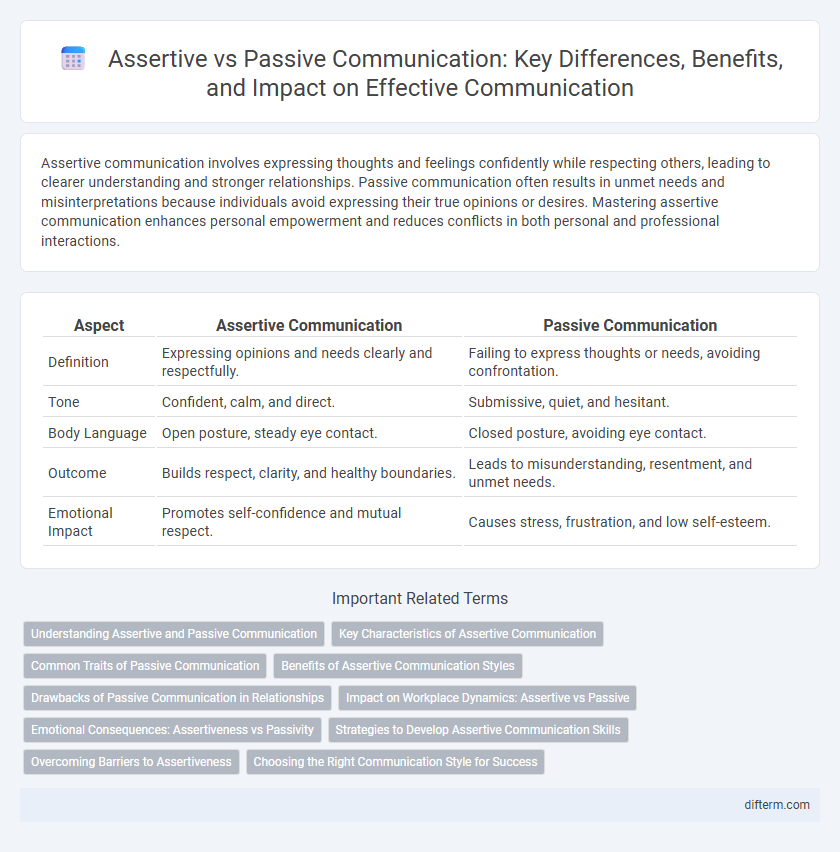Assertive communication involves expressing thoughts and feelings confidently while respecting others, leading to clearer understanding and stronger relationships. Passive communication often results in unmet needs and misinterpretations because individuals avoid expressing their true opinions or desires. Mastering assertive communication enhances personal empowerment and reduces conflicts in both personal and professional interactions.
Table of Comparison
| Aspect | Assertive Communication | Passive Communication |
|---|---|---|
| Definition | Expressing opinions and needs clearly and respectfully. | Failing to express thoughts or needs, avoiding confrontation. |
| Tone | Confident, calm, and direct. | Submissive, quiet, and hesitant. |
| Body Language | Open posture, steady eye contact. | Closed posture, avoiding eye contact. |
| Outcome | Builds respect, clarity, and healthy boundaries. | Leads to misunderstanding, resentment, and unmet needs. |
| Emotional Impact | Promotes self-confidence and mutual respect. | Causes stress, frustration, and low self-esteem. |
Understanding Assertive and Passive Communication
Assertive communication involves expressing thoughts and feelings openly and respectfully, ensuring clear and direct interaction. Passive communication tends to avoid confrontation, leading to unclear messages and unmet personal needs. Understanding these styles helps improve interpersonal relationships by promoting clarity and mutual respect.
Key Characteristics of Assertive Communication
Assertive communication features clear, direct expression of thoughts and feelings while respecting others' rights, balancing honesty with empathy. It involves confident body language, like maintaining eye contact and steady tone, promoting mutual understanding and reducing conflicts. This style fosters healthy relationships by encouraging open dialogue and active listening without aggression or passivity.
Common Traits of Passive Communication
Passive communication often involves avoiding eye contact, speaking softly, and yielding to others' opinions, which can lead to misunderstandings and unmet needs. Individuals displaying passive communication may struggle with expressing their thoughts or desires clearly, resulting in increased frustration and resentment. This communication style is marked by a lack of assertiveness, causing difficulty in setting boundaries and advocating for oneself effectively.
Benefits of Assertive Communication Styles
Assertive communication enhances clarity by expressing thoughts and needs directly while respecting others, leading to more effective interpersonal interactions. This communication style fosters higher self-esteem and reduces stress by encouraging honest and confident dialogue. Adopting assertive communication improves conflict resolution and builds stronger, more trusting relationships in both personal and professional settings.
Drawbacks of Passive Communication in Relationships
Passive communication often leads to misunderstandings and unresolved conflicts in relationships due to the lack of clear expression of needs and feelings. Individuals who use passive communication may experience decreased self-esteem and increased resentment as their boundaries remain unasserted. Over time, this communication style can erode trust and intimacy, making it difficult to maintain healthy, balanced relationships.
Impact on Workplace Dynamics: Assertive vs Passive
Assertive communication fosters a transparent and respectful workplace, encouraging collaboration and reducing misunderstandings by expressing thoughts and needs clearly. In contrast, passive communication often leads to unvoiced grievances, decreased morale, and impaired team productivity due to avoided conflicts and unclear expectations. Organizations that promote assertiveness typically experience improved employee engagement and more effective conflict resolution, enhancing overall workplace dynamics.
Emotional Consequences: Assertiveness vs Passivity
Assertive communication fosters emotional resilience by promoting clarity and self-respect, reducing feelings of frustration and anxiety. Passive communication often leads to internalized stress, resentment, and diminished self-esteem due to unmet needs and suppressed emotions. Adopting assertiveness enhances emotional well-being and interpersonal satisfaction by encouraging honest expression and healthy boundaries.
Strategies to Develop Assertive Communication Skills
Practicing clear and direct expression of thoughts and feelings improves assertive communication skills by fostering mutual respect and understanding. Using "I" statements reduces defensiveness and promotes accountability in conversations. Regularly engaging in role-playing scenarios helps build confidence in setting boundaries and advocating personal needs effectively.
Overcoming Barriers to Assertiveness
Overcoming barriers to assertiveness requires recognizing and challenging ingrained beliefs that equate passivity with politeness or fear of conflict with vulnerability. Developing clear, confident verbal and nonverbal communication skills helps individuals express needs and boundaries without aggression or submission. Building assertiveness enables healthier relationships, enhances self-esteem, and fosters effective conflict resolution in personal and professional settings.
Choosing the Right Communication Style for Success
Choosing the right communication style is essential for successful interactions, with assertive communication fostering clarity and confidence by expressing thoughts respectfully and directly. Passive communication often leads to misunderstandings and unmet needs, as individuals may avoid confrontation or fail to convey their true feelings effectively. Embracing assertive communication enhances relationships and drives positive outcomes by balancing honesty with empathy.
assertive vs passive communication Infographic

 difterm.com
difterm.com